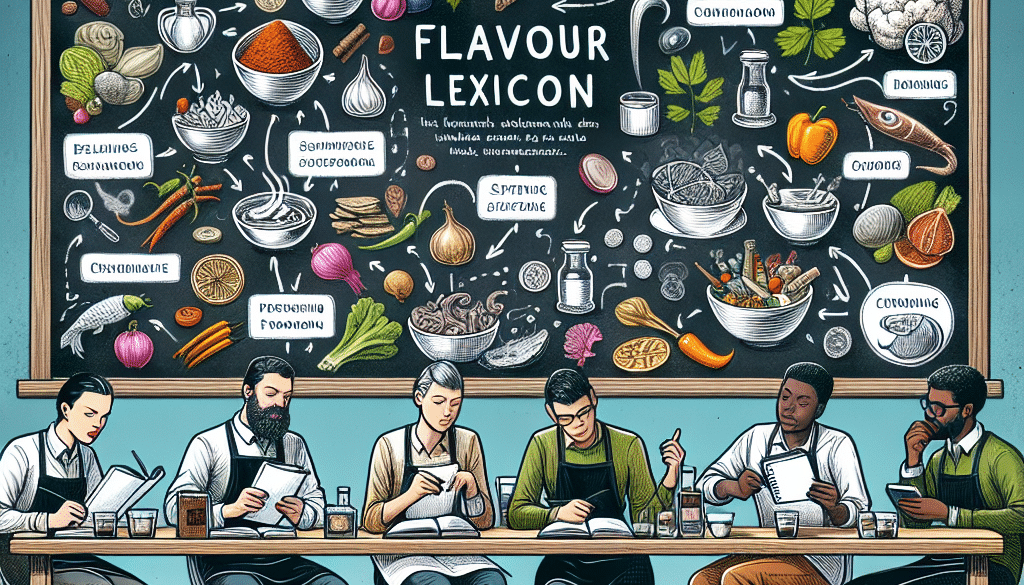Taste Talk: Developing a Flavour Lexicon
-
Table of Contents
- Flavour Lexicon Development: Enhancing Sensory Vocabulary
- Understanding the Importance of a Flavour Lexicon
- The Building Blocks of Taste
- Creating a Flavour Lexicon: A Step-by-Step Approach
- 1. Sensory Analysis
- 2. Descriptive Language
- 3. Standardization
- 4. Refinement and Expansion
- Case Studies: Successful Flavour Lexicons in Action
- Statistics and Research on Flavor Perception
- Conclusion: The Art and Science of Flavor Description
- Enhance Your Products with ETprotein’s High-Quality Proteins
Flavour Lexicon Development: Enhancing Sensory Vocabulary

The way we talk about taste is as complex as the flavors we experience. A well-developed flavour lexicon is not just a tool for food critics and sommeliers; it’s a fundamental asset for anyone involved in the food and beverage industry, from product development to marketing. This article delves into the intricacies of developing a flavour lexicon, providing valuable insights and examples to help professionals and enthusiasts alike articulate the sensory experiences of taste more effectively.
Understanding the Importance of a Flavour Lexicon
Before we can develop a flavour lexicon, it’s crucial to understand its significance. A flavour lexicon serves as a standardized language that enables individuals to communicate about taste and aroma with precision and consistency. It’s particularly important in the following contexts:
- Quality Control: Ensuring product consistency across batches.
- Product Development: Creating new flavors that appeal to target markets.
- Marketing: Describing product attributes to consumers in a relatable way.
- Consumer Education: Helping consumers develop a more sophisticated palate.
The Building Blocks of Taste
To construct a flavour lexicon, one must first understand the basic elements of taste. Traditionally, these have been categorized as sweet, sour, salty, bitter, and umami. However, this is just the tip of the iceberg. Texture, temperature, and even sound can influence our perception of flavor. The interaction of these elements creates a complex sensory experience that a flavour lexicon aims to capture.
Creating a Flavour Lexicon: A Step-by-Step Approach
Developing a flavour lexicon is a meticulous process that involves several steps:
1. Sensory Analysis
Professional tasters and sensory scientists analyze a wide range of food and beverage products to identify and record distinct flavors and aromas. This process often involves controlled tasting sessions and the use of tools like flavor wheels and aroma kits.
2. Descriptive Language
Once the basic flavors are identified, the next step is to expand upon them with descriptive language. This involves finding the right words to describe each nuance, which can be as specific as “grassy” for certain green teas or “caramelized” for roasted coffee beans.
3. Standardization
To ensure consistency, the terms used in the lexicon must be standardized. This often involves training sessions for tasters to calibrate their understanding and use of the lexicon’s terms.
4. Refinement and Expansion
A flavour lexicon is not static; it evolves with changing consumer preferences and the introduction of new products. Regular updates and refinements are necessary to keep it relevant and useful.
Case Studies: Successful Flavour Lexicons in Action
Several industries have developed robust flavour lexicons that have become critical to their success:
- The Wine Industry: Perhaps the most famous example, the wine industry’s lexicon includes terms like “oaky,” “tannic,” and “full-bodied.”
- The Coffee Industry: Coffee experts use descriptors such as “acidic,” “earthy,” and “floral” to differentiate between blends and roasts.
- The Chocolate Industry: Chocolate tasting involves a lexicon with terms like “fruity,” “nutty,” and “malty” to describe the complex flavors of different cocoa beans.
Statistics and Research on Flavor Perception
Research in the field of sensory science has shown that individuals can perceive a wide range of flavors, but the ability to describe them accurately can be improved with training. Studies have indicated that trained tasters are not only more consistent in their descriptions but also more sensitive to subtle flavor differences.
Conclusion: The Art and Science of Flavor Description
Developing a flavour lexicon is both an art and a science. It requires a deep understanding of sensory perception, a rich vocabulary, and a commitment to standardization and education. By investing in the development of a comprehensive flavour lexicon, the food and beverage industry can enhance communication, improve product development, and elevate the consumer experience.
Enhance Your Products with ETprotein’s High-Quality Proteins
If you’re in the food and beverage industry looking to develop products with exceptional taste and nutritional value, consider ETprotein’s range of protein products. Their organic bulk vegan proteins and L-(+)-Ergothioneine are characterized by a neutral taste, non-GMO, and allergen-free attributes, making them an excellent choice for a variety of applications.
ETprotein’s commitment to quality and their extensive product range can help you meet the growing demand for plant-based and health-conscious options. Whether you’re creating sports nutrition supplements, weight management products, or health and wellness foods, ETprotein has the ingredients to support your goals.
About ETprotein:
ETprotein, a reputable protein and L-(+)-Ergothioneine (EGT) Chinese factory manufacturer and supplier, is renowned for producing, stocking, exporting, and delivering the highest quality organic bulk vegan proteins and L-(+)-Ergothioneine. They include Organic rice protein, clear rice protein, pea protein, clear pea protein, watermelon seed protein, pumpkin seed protein, sunflower seed protein, mung bean protein, peanut protein, and L-(+)-Ergothioneine EGT Pharmaceutical grade, L-(+)-Ergothioneine EGT food grade, L-(+)-Ergothioneine EGT cosmetic grade, L-(+)-Ergothioneine EGT reference grade and L-(+)-Ergothioneine EGT standard. Their offerings, characterized by a neutral taste, non-GMO, allergen-free attributes, with L-(+)-Ergothioneine purity over 98%, 99%, cater to a diverse range of industries. They serve nutraceutical, pharmaceutical, cosmeceutical, veterinary, as well as food and beverage finished product distributors, traders, and manufacturers across Europe, USA, Canada, Australia, Thailand, Japan, Korea, Brazil, and Chile, among others.
ETprotein specialization includes exporting and delivering tailor-made protein powder and finished nutritional supplements. Their extensive product range covers sectors like Food and Beverage, Sports Nutrition, Weight Management, Dietary Supplements, Health and Wellness Products, and Infant Formula, ensuring comprehensive solutions to meet all your protein needs.
As a trusted company by leading global food and beverage brands and Fortune 500 companies, ETprotein reinforces China’s reputation in the global arena. For more information or to sample their products, please contact them and email sales(at)ETprotein.com today.














